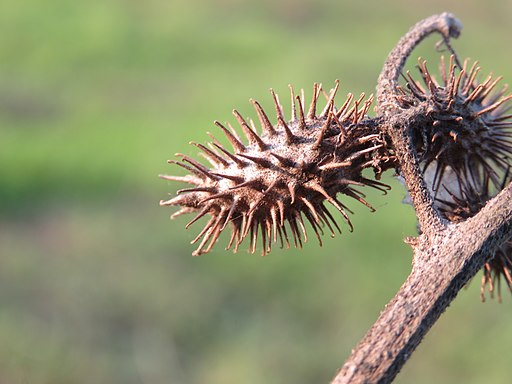The rise of the Omicron variant has revived discussions of whether Americans will eventually be getting both flu and coronavirus shots within the next few years. The Omicron variant of Covid19 had a number of novel mutations in its S-Spike protein that led researchers to question whether existing vaccines would be effective against this new variant.
An easy way to understand the S-Spike protein is to think of it as being similar to the spikes on the outside of a cockleburr. Human lungs are lined with “alveoli”, tiny air-sacs that are filled with blood vessels that absorb oxygen from inhaled air and introduce it to the blood stream. The Covid-19 virus lodges its spike into the surface layer of the alveoli in a manner that’s similar to how a cockleburr attaches itself to your pants leg. Advanced Covid-19 infection results in scar tissue forming on the alveoli, creating the “ground glass opacity” that’s observable in lung-scans of Covid-19 patients. Most of the efforts at defeating Covid-19 have focused on developing antibodies that degrade the S-spike protein, so that instead of the virus being able to colonize the surface of alveolar tissues, the hobbled virus just bounces around harmlessly until it is finally shed through exhalation, or absorbed and disposed of by the immune system.

If enough Americans get vaccinated against Covid-19 within a relatively short period of time, then the potential for new infection and variants diminishes, as there are fewer hosts that the existing virus can successfully colonize. Viruses mutate very quickly and every single person who gets Covid-19 has the potential to be the person that becomes the source of the next variant. If American conservatives continue to refuse to wear masks or get vaccinated, then the potential for new variants obviously increases, and the prospect of an annual Covid shot becomes more likely.
Scientists do not currently know exactly what percentage of the population would need to be vaccinated, or have experienced Covid-19 infection to achieve herd immunity. In a recent article posted to YaleMedicine.org, Manisha Juthani, MD, a Yale Medicine infectious diseases specialist said: “The reality is that we don’t know when herd immunity will occur. We haven’t had this disease before. We can’t say for sure what percentage of the population needs to be reached. There is not a certain number or cut-off; it’s a gradient, meaning we’ll know we’ve reached it if we see the number of cases, hospitalizations, and deaths go down. An overall improvement of our numbers will tell us we are reaching that threshold.”
Flu shots vary every year as medical researchers try to predict which flu strains will predominate in any given year, and then attempt to develop a flu shot that will protect against those flu strains. An annual Covid booster would likely work along similar lines. The ultimate fear of physicians is that a strain of Covid will emerge that has the same mortality rate as the original SARS virus, which had an overall mortality rate of greater than 30%, and a mortality rate of greater than 50% for people over the age of 65.
Until we reach that as-yet unknown threshold, every vaccine skeptic becomes a potential host for a new variant. Because Covid-19 is so new, we simply do not know what the threshold figure is to achieve herd immunity. The longer American conservatives continue circulating anti-mask and anti-vax skepticism, the more likely it is that annual Coronavirus boosters, designed to address prominent new variants, will be distributed alongside annual flu shots.